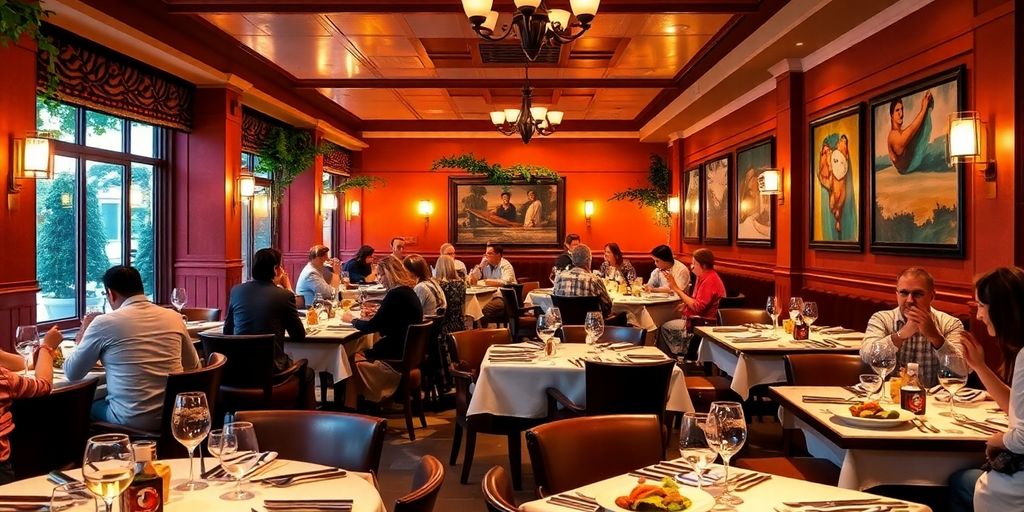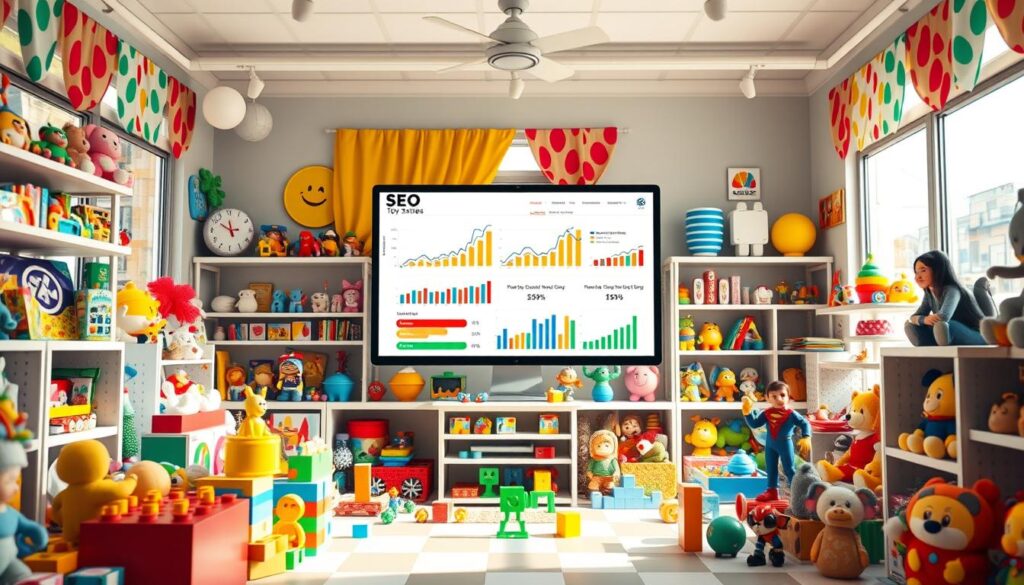So, you’re running a restaurant and you’ve heard about SEO, but what does it really mean for your business? Simply put, SEO or Search Engine Optimization is all about making your restaurant more visible online. When folks search for “best pasta near me,” you want your restaurant to pop up first, right? That’s where SEO comes in. It’s not just about getting more clicks; it’s about attracting more hungry customers to your tables. In this article, we’ll break down what SEO for restaurants is all about and why it’s something you should care about.
Key Takeaways
- SEO helps restaurants show up in online searches, bringing in more customers.
- A strong SEO strategy can improve your restaurant’s visibility and competitiveness.
- Local SEO is crucial for attracting nearby customers actively searching for dining options.
- Avoiding common SEO mistakes, like ignoring mobile optimization, is essential.
- Regularly measuring your SEO success ensures your strategies are working.
Understanding SEO for Restaurants
Defining Search Engine Optimization
Search Engine Optimization, or SEO, is all about making your restaurant’s website pop up when people search for places to eat online. Imagine someone typing "Italian restaurant" into Google. SEO is the magic that helps your place show up on that list. It’s about using the right keywords, tweaking your site’s structure, and getting other sites to link back to yours. Essentially, it’s the art of making your site more appealing to search engines so more people can find you.
Importance of SEO in the Restaurant Industry
Why bother with SEO? Well, in the restaurant world, showing up on the first page of search results can mean more customers walking through your door. Most people don’t click past the first page of search results. So, if your restaurant isn’t there, you’re missing out on a bunch of potential diners. SEO helps boost your online presence, making it easier for hungry folks to find you, and keeps you competitive in a crowded market.
How SEO Works for Restaurants
So, how does SEO work for a restaurant? It starts with figuring out what words people use when they’re looking for a place to eat. Then, you sprinkle those words throughout your website. You also need to make sure your site is easy to navigate and loads quickly. Another biggie is setting up a Google Business Profile and collecting reviews. These steps help search engines see your site as relevant and trustworthy, pushing it higher up in search results.
SEO isn’t a one-time thing; it’s an ongoing process. As search engines update how they rank sites, you’ll need to keep tweaking your strategy to stay on top.
Benefits of SEO for Restaurants
Increased Online Visibility
When your restaurant shows up at the top of search results, it becomes much easier for potential customers to find you. SEO plays a vital role in boosting your online presence, making your business more accessible to people actively searching for dining options. This increased visibility can lead to more foot traffic and online orders, as customers often choose restaurants that appear prominently in search results.
Enhanced Customer Experience
SEO isn’t just about getting more clicks; it’s also about creating a better experience for your visitors. A well-optimized website is usually faster, easier to navigate, and more mobile-friendly. This means customers can find what they need quickly, whether it’s your menu, location, or hours of operation. A smooth online experience can make a big difference in how customers perceive your restaurant.
Cost-Effective Marketing Strategy
Traditional advertising can be expensive, but SEO offers a more budget-friendly alternative. Once your website is optimized, it continues to attract organic traffic without the ongoing costs associated with paid ads. This makes SEO a smart long-term investment for restaurants looking to maximize their marketing budget. By focusing on restaurant SEO, you can increase your customer base without breaking the bank.
Investing in SEO is like planting a seed that grows over time, bringing in new customers while saving on advertising costs. It’s a strategy that pays off in the long run, helping your restaurant thrive in a competitive market.
Key Components of Restaurant SEO
Keyword Research and Implementation
When it comes to SEO for restaurants, keyword research is like the GPS for your online strategy. You need to know what words people are using to find places to eat. Start with basic terms related to your food, location, and any special dishes you offer. For example, if you run a pizza place in New York, you might focus on phrases like "best pizza in New York" or "gluten-free pizza Manhattan." Once you’ve got your keywords, sprinkle them naturally throughout your website—think menus, blog posts, and even image descriptions. This helps search engines understand what your restaurant is all about, making it easier for potential customers to find you.
Optimizing Google Business Profile
Your Google Business Profile is like your restaurant’s digital storefront. It’s where people get their first impression of you online. Make sure your profile is up-to-date with accurate info like your address, phone number, and hours. Upload some mouth-watering photos of your dishes and your dining space. Encourage happy customers to leave reviews—this builds trust and can boost your visibility in local searches. Remember, a well-maintained profile can be a game-changer in attracting diners who are searching for a bite nearby.
Building Local Citations
Local citations are mentions of your restaurant’s name, address, and phone number on other websites, kind of like digital breadcrumbs leading back to you. These can be in directories, review sites, or local blogs. The more consistent these citations are, the better. They help search engines confirm your location and can improve your ranking in local search results. Think of it as building your restaurant’s online reputation—every mention counts!
"For restaurants, local SEO isn’t just about getting found; it’s about building a connection with the community and making sure your place is the first one locals think of when they’re hungry."
By focusing on these components, you’re setting up your restaurant for online success. Keep things simple, stay consistent, and you’ll see the benefits in no time.
Local SEO Strategies for Restaurants
Importance of Local Search
Local search is a game-changer for restaurants. When someone nearby is hungry and searching for a place to eat, you want your restaurant to pop up first. This is where local SEO comes in. Local search optimization helps your restaurant appear in search results when people are looking for dining options in their area. To get started, make sure your business is listed on major platforms like Google, Yelp, and TripAdvisor. Consistency is key—ensure your restaurant’s name, address, and phone number are the same across all platforms.
Engaging with Customer Reviews
Customer reviews can make or break your restaurant’s online reputation. They not only influence potential diners but also play a role in your local search rankings. Encourage satisfied customers to leave positive reviews on platforms like Google and Yelp. Responding to reviews, whether they are positive or negative, shows that you care about your customers’ experiences. This engagement can improve your restaurant’s image and help build trust with your audience.
Utilizing Social Media for Local SEO
Social media is more than just a place to share photos of your latest dish; it’s an essential tool for boosting your local SEO. By engaging with your community on platforms like Instagram and Facebook, you can increase your restaurant’s visibility. Share updates, promote events, and interact with your followers to keep them engaged. Use local hashtags and geotags to reach a wider audience in your area. This not only helps in building a community but also signals to search engines that your restaurant is active and relevant in the local scene.
Common SEO Mistakes to Avoid

Neglecting Mobile Optimization
In today’s fast-paced world, a lot of people are checking out restaurants on their phones. If your site isn’t mobile-friendly, you’re likely losing potential customers. Google also prioritizes mobile-friendly websites in its rankings, so ignoring this could hurt your visibility. Make sure your site is responsive, meaning it looks good and works well on all devices, whether it’s a smartphone, tablet, or desktop.
Ignoring Analytics and Data
Running a restaurant is busy work, but if you’re not paying attention to your website’s analytics, you’re missing out on important insights. Tools like Google Analytics can show you how people are finding you and what they’re doing on your site. Without this data, it’s hard to know what’s working and what isn’t. Regularly checking these metrics can help you tweak your SEO strategy for better results.
Overlooking Content Quality
It’s tempting to slap together a few words and call it a day, but quality content is key for SEO. Search engines love fresh, relevant, and well-written content. If your site is full of outdated or poorly written text, it’s not going to rank well. Take the time to create engaging and informative content that answers your customers’ questions and highlights what makes your restaurant special.
"Quality content isn’t just about getting people to your site; it’s about keeping them there and turning them into loyal customers."
By avoiding these common mistakes, your restaurant can improve its online presence and draw in more customers. Remember, SEO is an ongoing process, and staying on top of these basics can make a big difference. For more insights on how to enhance your restaurant’s online visibility, consider exploring SEO for restaurants strategies that focus on local SEO, keyword research, and more.
Measuring SEO Success for Restaurants
Tracking Website Traffic
Keeping an eye on your website traffic is like checking the pulse of your online presence. You want to know how many people are visiting your site and where they’re coming from. Tools like Google Analytics can give you a breakdown of your traffic sources, whether it’s from search engines, social media, or direct visits. Understanding these patterns helps you see if your SEO strategies are working or if they need a tweak.
Analyzing Conversion Rates
It’s not just about getting people to your website; it’s about turning those visitors into paying customers. This is where conversion rates come in. Whether it’s making a reservation, ordering takeout, or signing up for a newsletter, you want to track how often these actions happen. A higher conversion rate means your site is doing a good job of convincing visitors to take the next step.
Monitoring Search Engine Rankings
You want your restaurant to pop up when someone searches for "best pizza near me" or "vegan brunch options." That’s where search engine rankings come into play. By keeping tabs on where your restaurant ranks for important keywords, you can gauge the effectiveness of your SEO efforts. If you’re not showing up on the first page, it might be time to revisit your strategy.
Measuring the success of your SEO efforts isn’t just about numbers. It’s about understanding how your online presence translates into real-world results. By focusing on traffic, conversions, and rankings, you can create a roadmap to success.
Future Trends in Restaurant SEO

Voice Search Optimization
Voice search is becoming a big deal in the way people look for stuff online. More and more folks are using their smart speakers and phones to find restaurants nearby. Imagine someone saying, "Hey Siri, find me a pizza place open now." That’s where voice search optimization comes in. Restaurants need to tweak their online presence to match how people talk, not just type.
The Role of AI in SEO
Artificial Intelligence (AI) is changing the game for SEO. It helps restaurants understand what their customers really want. AI tools can analyze tons of data, spotting trends and patterns that humans might miss. This means restaurants can tailor their content and marketing strategies better than ever. AI can also help in predicting what customers might be looking for next, giving restaurants a head start.
Adapting to Changing Consumer Behavior
Consumer habits are always shifting, especially with technology evolving so fast. People expect quick, easy access to info about where to eat. Restaurants need to keep up with these changes to stay relevant. This could mean anything from updating their websites to be more user-friendly, to engaging more with customers on social media. Staying on top of these trends helps restaurants meet their customers where they are, both online and offline.
In the fast-paced world of dining, adapting to new SEO trends isn’t just about keeping up—it’s about staying ahead of the competition. As consumers continue to change how they search and decide on dining options, restaurants must evolve their strategies to ensure they remain the top choice.
Wrapping It Up: SEO for Restaurants
So, there you have it. SEO might sound like a bunch of techy mumbo jumbo, but it’s really just about making sure your restaurant pops up when folks are searching for a bite to eat. It’s like putting up a big, bright sign that says, "Hey, we’re here!" Whether you’re running a cozy little cafe or a bustling bistro, getting your SEO game on can help bring more people through your doors. And let’s be honest, who doesn’t want more customers? Just remember, it’s not a one-and-done deal. Keep tweaking and updating your strategies to stay ahead of the curve. In the end, a little effort in SEO can go a long way in making your restaurant the go-to spot in town.
Frequently Asked Questions
What is SEO for restaurants?
SEO for restaurants is the practice of improving a restaurant’s online presence so it appears higher in search engine results. This helps more people find the restaurant when they search for places to eat online.
Why is SEO important for my restaurant?
SEO is important because it makes your restaurant more visible to potential customers searching online, leading to more visitors and possibly more sales.
How can I improve my restaurant’s SEO?
You can improve your restaurant’s SEO by using relevant keywords on your website, optimizing your Google Business Profile, and encouraging customer reviews.
What are some common SEO mistakes to avoid?
Common SEO mistakes include neglecting mobile optimization, ignoring analytics, and overlooking the quality of content on your website.
How do I measure the success of my restaurant’s SEO?
You can measure SEO success by tracking website traffic, analyzing conversion rates, and monitoring your search engine rankings.
What are future trends in restaurant SEO?
Future trends include optimizing for voice search, using AI in SEO strategies, and adapting to changing consumer behaviors.






